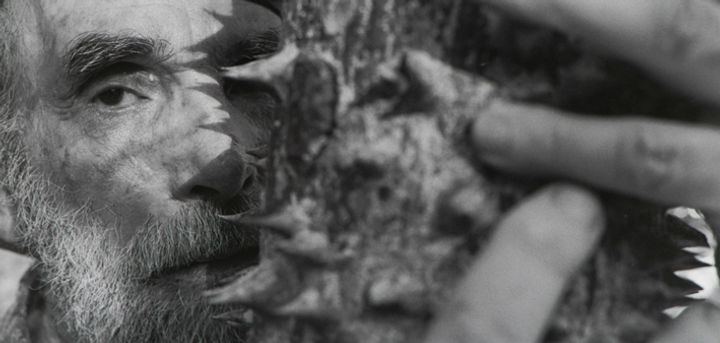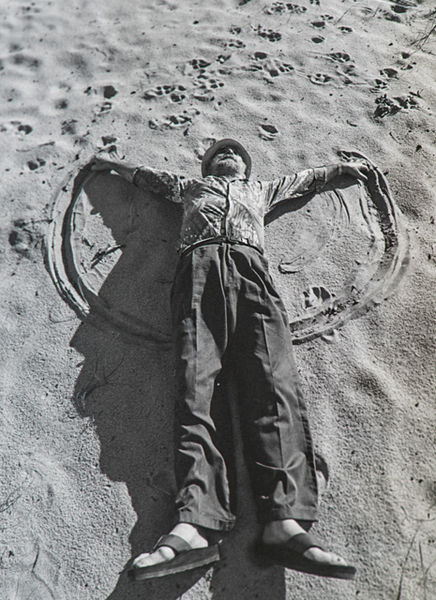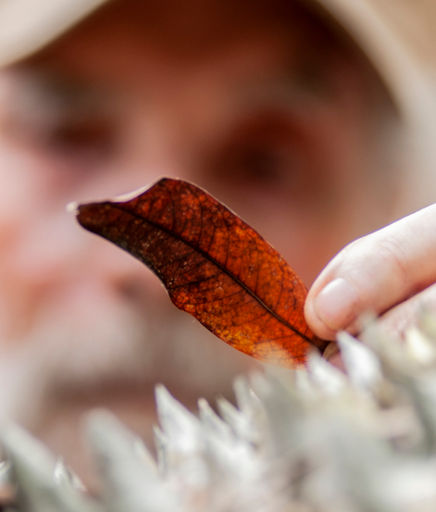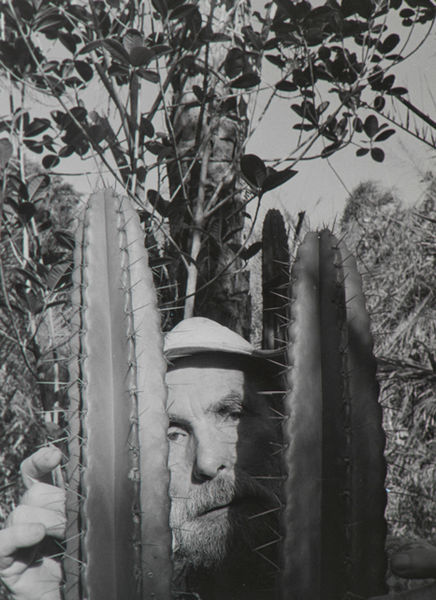
© Luiz Garrado
His Conceptual Framework: The Integral Naturalism
Frans Krajcberg’s works have transcended the 20th century without losing their relevance. His message remains more pertinent than ever. His artworks and his message are so intimately intertwined that it is difficult to separate one from the other. Nature serves as an open-air studio from which he draws his inspiration. It also justifies his role as an artist.
An atypical artist: Trained according to the standards of his time at the Stuttgart Academy of Fine Arts, Frans Krajcberg relentlessly broke free from all recognized artistic movements to express himself in a deeply personal way, creating untitled and undated works whose emotional power remains undiminished.
A protean artist: He employed every possible medium—painting, sculpture, photography, even film—seamlessly blending classical and contemporary disciplines without constraints.
In the aftermath of the war, Krajcberg chose exile over assimilation—fleeing to Ibiza and Brazil rather than integrating into the artistic circles he encountered. Faced with the immensity of nature, he developed a profound sense of observation and wonder, and early on, the desire to bear witness and take action.
For him, Art was never an end in itself, but a means—a way to reach us, to deliver a message, to share his revolt. Throughout his life, he relentlessly shaped forms, searching for new modes of expression to fulfill what he saw as a mission. Imprints, collages, shadows, burned wood—but also photography and film—became his tools to communicate beyond boundaries. He entrusted his works with the role of screaming on his behalf.
It was in Paris, in the 1960s, that he became convinced he had found in artistic expression a powerful way to defend nature. At a time when abstraction and informal painting were losing momentum, environmental concerns began to emerge in political and societal debates—for the very first time.

© Luiz Garrado
In 1978, they embarked on a journey down the Rio Negro with the painter Sepp Baendereck.
Far from everything, in the heart of the Amazon, they reflected deeply and exchanged views on the role of Art and the Artist in our society. The Journal of the Rio Negro traces this path toward what would become the foundations of Integral Naturalism. For both of them, nature would henceforth lie at the very heart of cultural and artistic concerns.
“This Amazonian nature is so powerful that it imposes itself on me as a true discipline. The Amazon will be the university, the alma mater, the great school of my perception,” declared Pierre Restany. For his part, Frans Krajcberg was affirmed in the vision that had struck him upon arriving in Brazil: fragments of nature are themselves works of art.
The artist must reveal their beauty to the world in order to prevent their destruction. This “truth” imposed itself on him “as a moral call to order for our culture.” Elements, trees, people, plants, animals—all form an inseparable whole.
“The nature of the Amazon questions my modern man’s sensitivity. It also calls into question the scale of traditionally recognized aesthetic and artistic values. Here, we are faced with a world of forms and vibrations, a mystery in perpetual motion...”
From then on, and for the rest of his life, Frans Krajcberg invited us to look at nature as a work of art. An inexhaustible source of inspiration, it offered him constant wonder, which he sought to share:
“To capture the smallest trace of its fleetingness, to show it in its raw beauty or in its motion as the hours of the day pass, to watch the sun, the wind, and the water resonate with it...” First fascinated by the infinite variety of every raw material fragment, he chose to entrust his works with the task of screaming in his place: “Sometimes, I fall into beauty. A tree struck by fire can be beautiful—but if you go into its story, it’s tragic. I would like my sculptures to scream, but how can I make them do that? Sometimes I think they’ve become too beautiful and no longer scream. Sometimes, the more violent they are, the more they move into the aesthetic. And so I can think: death can be beautiful.”

© Tim Carrol, 1993
A tireless craftsman: Frans Krajcberg mastered every technique within his reach and drew inspiration from both traditional and experimental methods.
A pioneer: As early as the 1980s and 1990s, he emerged as one of the forerunners of the Anthropocene movement, which recognizes humanity's decisive role in the planet’s ecological balance.
A radical artist: From early on and throughout his life, he remained an active witness—denouncing, warning, and bearing testimony. For him, the artist stood “at the heart of every civilizational project—integrally and radically.”

© Luiz Garrado
Artists like Joseph Beuys and Hans Haacke began to question the role of Art during this time of upheaval. Civilized man had created a world overrun by manufactured objects, relentlessly exploiting the Earth's natural resources. The time had come to recognize his own vulnerability.
In the late 1960s, Arte Povera, and later in the 1970s, Land Art, began exploring new paths, drawing inspiration from raw materials and the landscape itself. But whereas Arte Povera operated with a spirit of provocation—rejecting Op-Art—Frans Krajcberg embraced instead the idea of movement. For him, the materials that inspired him were far from “poor.” On the contrary, their beauty spoke for itself—even when serving to denounce the destruction of nature by human hands.
And unlike Land Art, which intervenes directly in the landscape, Krajcberg never alters nature itself. Instead, he selects natural elements—scorched, fallen, discarded—and transforms them to elevate their presence, while subtly subverting artistic codes and conventions.
Frans Krajcberg also sets himself apart from the Nouveaux Réalistes, a movement founded by Pierre Restany during this pivotal period. At first, the art critic and historian saw Krajcberg’s act of appropriating nature as somewhat akin to the approach of the Nouveaux Réalistes. This group sought to cast a fresh eye on artificial and manufactured objects—those created to meet the demands of urban life—and to reveal their poetic reality. At the time, Restany believed this was the only viable path to renew contemporary art.

© Luiz Garrado
For him, Nature and Art were now inseparable.
“I am a man entirely bound to nature, on which my survival and creativity depend... Nature gave me strength, brought back the joy of feeling, thinking, working. Of surviving. I would walk through the forest and discover an unknown world. I was discovering life.
Pure life: to be, to change, to continue, to receive light, warmth, humidity. True life: when I’m in nature, I think truthfully, I speak truthfully, I question truthfully.
When I look at it, I feel how it moves: it is born, it dies, the continuation of life. I had built my house in the forest. A wild cat had adopted me. I collected orchids.
I probably had the largest orchid collection in Brazil.”
The second half of the 20th century gave him the time to forge the artistic tools to carry his message and make his cry of revolt resonate: “My work is a long, loving struggle with nature. I could show a fragment of that beauty. I did it. But I can’t repeat that gesture endlessly. How can I make this piece of wood mine?
How do I express the consciousness I have of it?
Where is my place in this life that includes and surpasses me? Until now, I have not mastered nature.
I have learned to work with it.”
The beginning of the 21st century allowed him to express himself and cry out with force—using only the obvious beauty and immediate emotional power of his works as a weapon.
Tirelessly, until his passing in 2017, he created and made his message resonate: that of a rebel artist, standing against the destruction of nature, to preserve the planet and pass it on to future generations.
